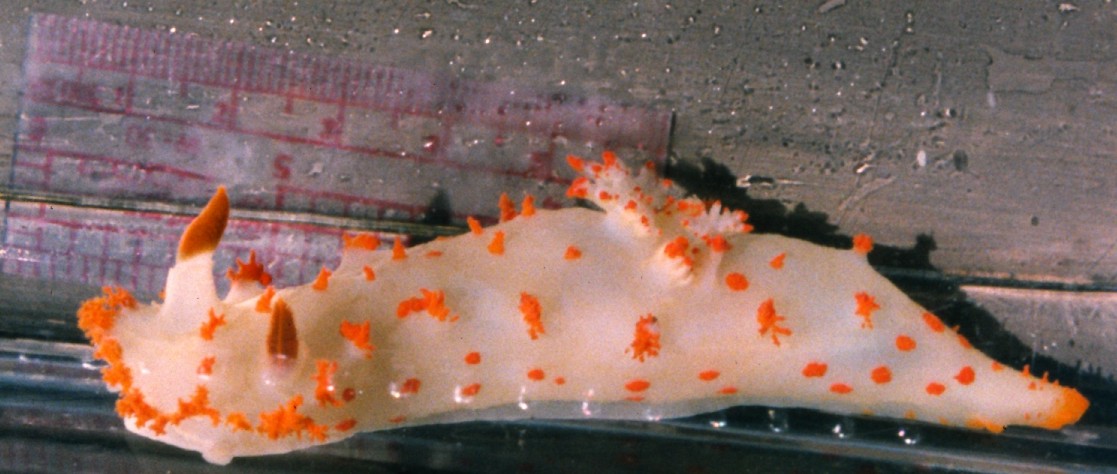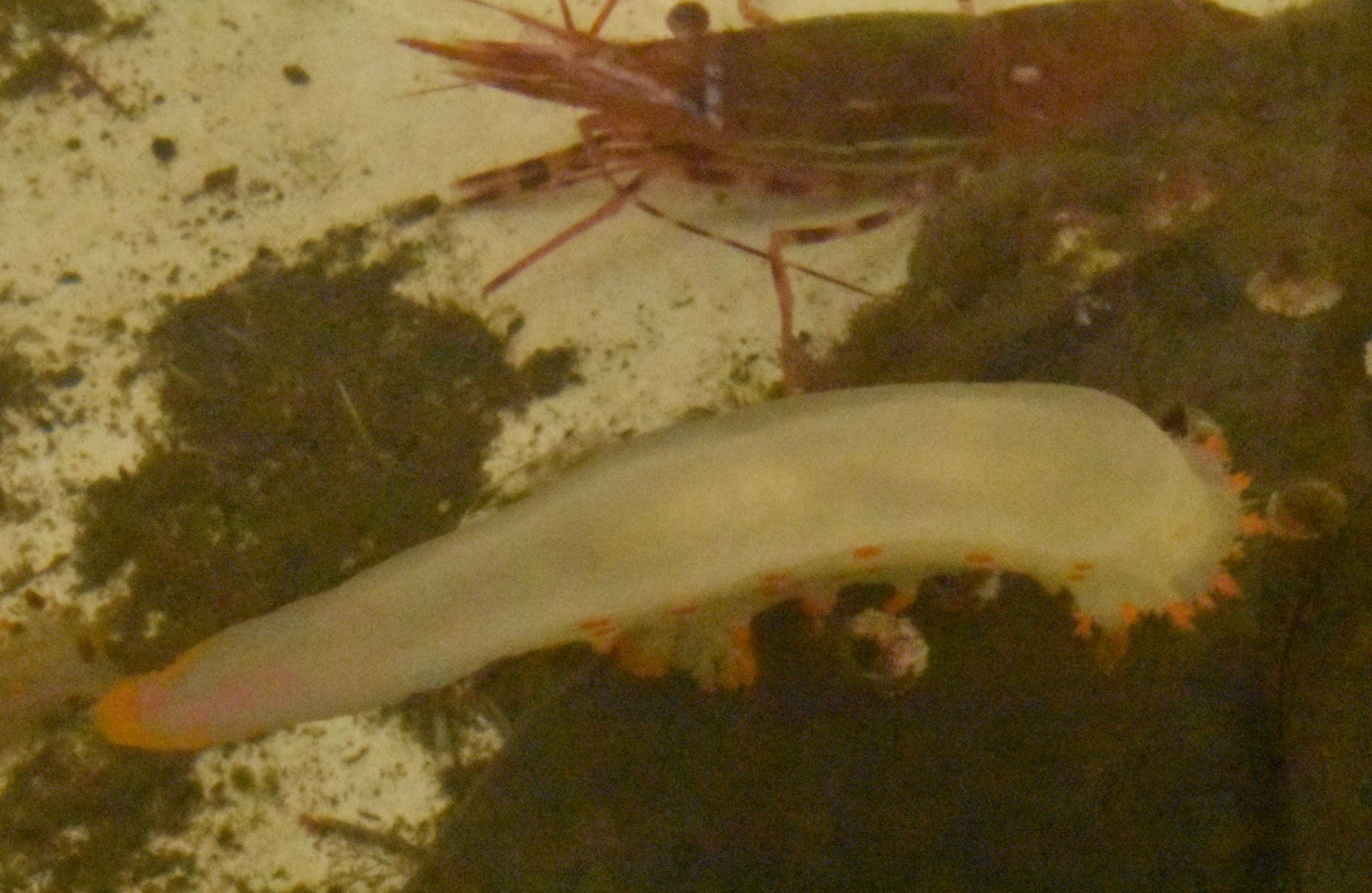Description: As with many dorid nudibranchs, the anus of this species is found on the dorsum 1/3 to 1/4 from the posterior end, ringed by gills (see photo above). The white body, is opaque and limaciform (elongated shape with tail like a slug), flatter toward the head than farther back. Oral veil is a bit wider than the body and has a row of short, arborescent appendages from end to end. The smallest of these may be white or orange; larger ones tend to be white at the base and orange distally. The rhinophores are perfoliate and the orange or vermilion clavus can be completely retracted into the sheath. The edge of the rhinophore sheath is smooth or bumpy. The rhinophore stalk is cylindrical and white. The dorsum has large conical or round orange tubercles, and there are flat orange patches both on the dorsum and on the sides of the body. Each side of the dorsum has 5-7 long, orange club-shaped tubercles which bend slightly toward the midline. Gill has 5 tripinnate leaves with orange or vermilion tips surrounding the anus. The clavus of the rhinophore and the tips of the gills are usually darker than the tubercles on the body are. Foot is round in front and pointed in the back. The genital opening is on the right side behind head, surrounded by 3 lobes. Total length up to15 cm.
How to Distinguish from Similar Species: What was formerly called T. catalinae all along our coast plus in the northwestern Pacific has now been divided into two species by molecular and morphological means (Jung et al., 2020). The sister species of T. catalinae is T. modesta. Triopha modesta is similar to T. catalinae in many ways but its body is translucent white or yellowish white. The clavus of the rhinophore and the tips of the gills are orange but usually lighter colored than the body tubercles are. The tubercles on the dorsum are small (smaller than in T. catalinae), flat or dendritic, and irregularly arranged, usually with 7-12 ahead of gill and 1-2 behind. It also has many small orange patches on the dorsum and body sides and 4-6 pairs of long, clublike tubercles on both sides of the dorsum. In larger animals these tubercles are globular and yellow on top and their stalk has two rows of small arborescent papillae. T. modesta is found in Korea, Japan, Siberia, and Alaska to California.
Geographical Range: From the Aleutian Islands, Alaska to the Gulf of California
Depth Range: Intertidal to 35 m.
Habitat: Rocky areas or around kelp beds.
Biology/Natural History: This is one of the largest nudibranchs able to crawl on the underside of the surface film in tide pools. It feeds on bryozoans such as Bugula californica by digesting the soft parts. Tide pool fish avoid Triopha, and this is believed to be because of some sort of chemical repellant. In Washington eggs have been observed in April and June. The coil of eggs formed is white or cream-colored (photo). The ribbon of eggs is attached to a solid surface by its shorter edge (photo). The free edge is wavy and appears like a ribbon. The species is usually one of the most common nudibranchs found near Rosario.
The Gulf of California population of this species is
somewhat but not
fully molecularly distinct from those on the open coast (Jung
et
al. 2020)
| Return to: | |||
| Main Page | Alphabetic Index | Systematic Index | Glossary |
References:
Dichotomous Keys:Flora and Fairbanks, 1966 (as Triopha carpenteri)
Kozloff 1987, 1996
Smith and Carlton, 1975 (as Triopha carpenteri)
General References:
Behrens,
1991
Harbo,
1999
Johnson
and Snook, 1955 (as Triopha carpenteri)
Kozloff,
1993
Morris,
et. al., 1980
Sept,
1999
Scientific Articles:
Jung, Dae-Wui, Terrence M. Gosliner, Tae-Jun Choi,
Hyun-Jong Kil, Anton
Chichvarkhin, Jeffrey H. R. Goddard, and Angel Valdes, 2020. The return
of the clown: pseudocryptic speciation in the North Pacific clown
nudibranch, Triopha
catalinae (Cooper, 1863) senso lato identified by
integrative taxonomic
approaches. Marine Biodiversity 50:84 pp. 1-17.
https://doi.org/10.1007/s/12526-020-01107-2
Web sites:
General Notes and Observations: Locations, abundances, unusual behaviors:
This nudibranch is usually one of the most commonly
found subtidally
along Sares Head and Northwest Island.
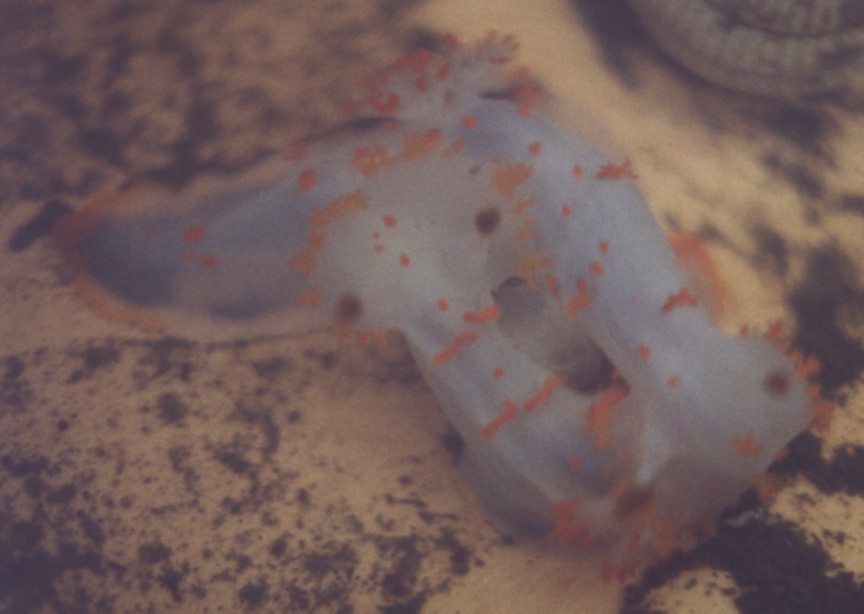
Two individuals mating (they are hermaphroditic).
This species mates very readily in aquaria if given half a
chance.
Photo by Dave Cowles, July 2000
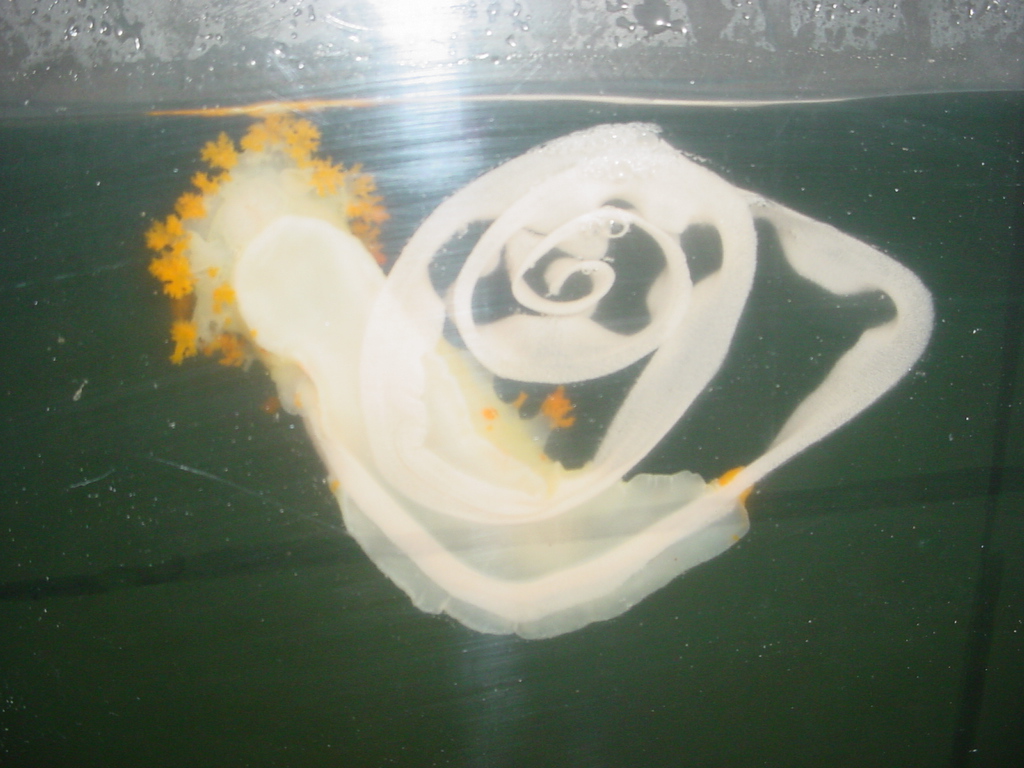
This individual is laying a string of eggs. View from
below.
Photo by Dave Cowles, 2-2004
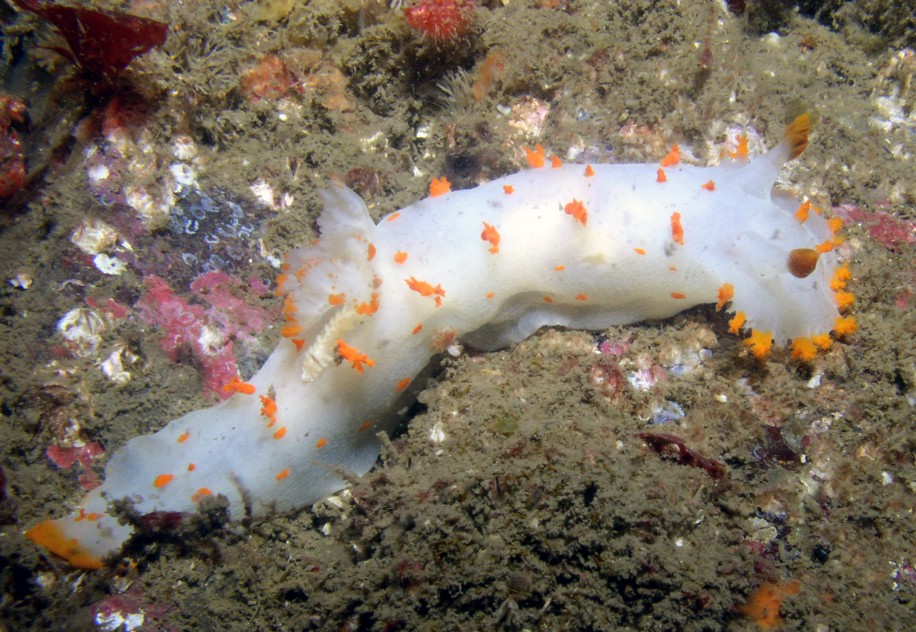
An underwater photo by Kirt Onthank, June 2007
Although this species can get quite large (the specimen pictured here is 8 cm long), it can still crawl upside-down clinging to the surface film of the water, as this individual is doing. The view is from above but since the animal is upside-down with its foot clinging to the surface film, the foot is uppermost. Photo by Dave Cowles, July 2017
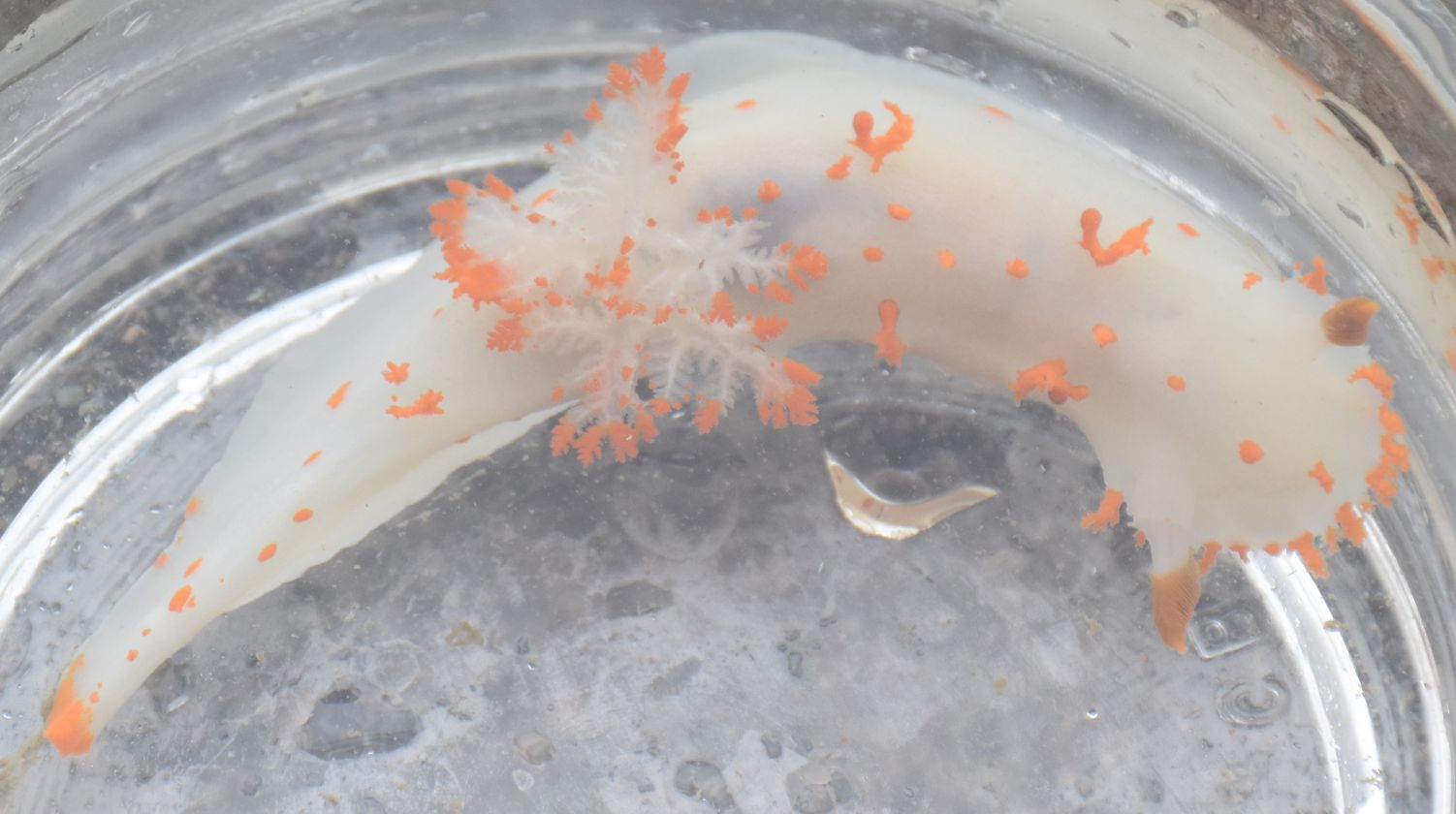
An individual photographed in 2020. This individual is about 10 cm
long. The distinctive features of T. catalinae can
be seen in the
rhinophores
and dorsal tubercles.
Photo by Dave Cowles
Authors and Editors of Page:
Dave Cowles (2007): Created original page. (An earlier version was worked on by Robbie Wheeling)
CSS coding for page developed by Jonathan Cowles (2007)
